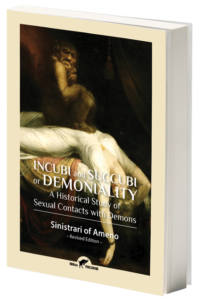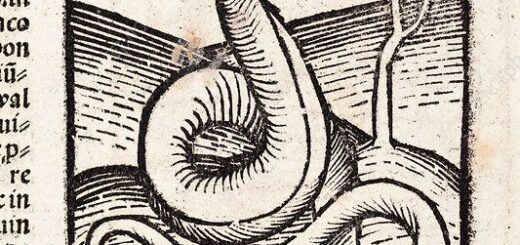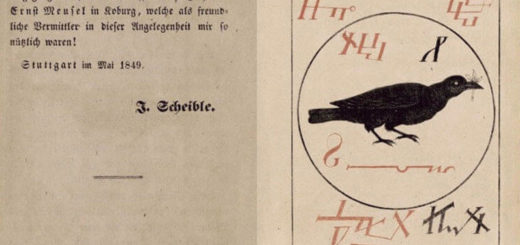The incubus or succubus – nightmare or astral sex date?
Although he left a very impressive oeuvre, only two works of the dark romantic painter Henry Fuseli have really become famous among the general public. The Nightmare or Incubus, both the 1781 and the 1810 version, have travelled the world, and there is a third version of unknown date. Not only via exhibitions or art magazines, but even as a frequently appearing illustration in the journals of Freudian psychoanalysts. Perhaps these works became such durable eye-catchers because they depict a situation that many people experiences once or sometimes even several times in their life: a nightmare, accompanied by a suffocating heavy chest pressure and the feeling of not being able to move the limbs.
Voor de Nederlandse versie klik hier
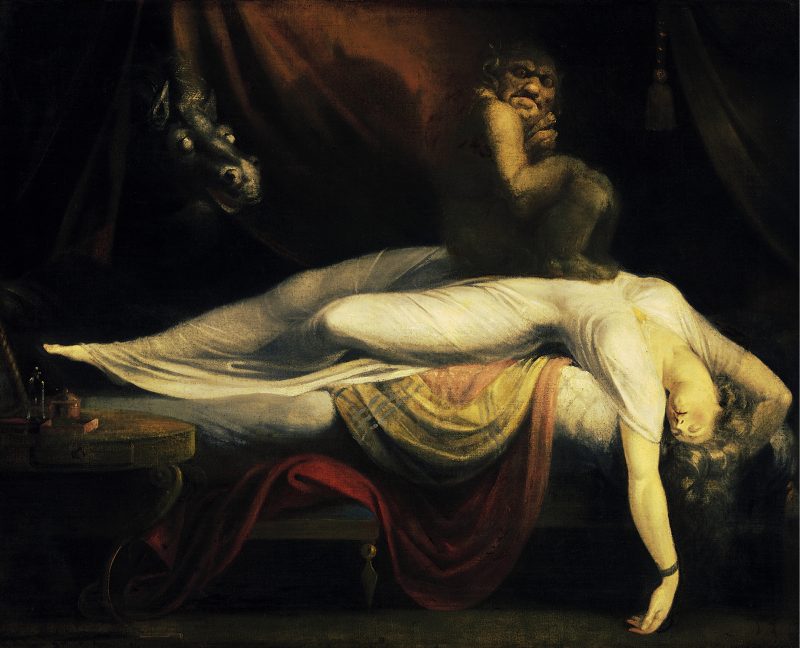
“The Nightmare” or “Incubus” in the 1781 version by Henry Fuseli
‘O’er her fair limbs convulsive tremors fleet
Start in her hands, and struggle in her feet;
In vain to scream with quivering lips she tries,
And strain in palsy’d lids her tremulous eyes;
In vain she wills to run, fly, swim, walk, creep;
The WILL presides not in the realm of SLEEP
On her fair bosom sits the Demon-Ape
Erect, and balances his bloated shape’
– Erasmus Darwin
Eating raw pork before going to bed
With the Nightmare or Incubus, the Swiss-English painter Henry Fuseli hit the bull’s-eye. The work was immediately copied by other artists and even by cartoonists of the time, who used the work to create a caricature of their political nightmares. From 1790 on-wards, a myth, as peculiar as it is persistent, arose around the painting through a nonsense publication in the Public Adviser about the source of Fuseli’s creativity.
Before going to bed, Fuseli would eat raw pork to evoke fierce dreams in himself. Even Thomas De Quincy – author of the famous Diary of an English Opium Eater – fell for it and later wrote: “…we hear it reported of Dryden and Fuseli in modern times, that they thought proper to eat raw meat for the sake of obtaining splendid dreams: how much better for such a purpose to have eaten opium.”
Eating raw or abundant amounts of meat before going to bed seems to have been a short rage among creatives who had read the Public Adviser, but Fuseli himself probably never sinned in it. He was once dumbfounded when he caught a number of artists around a large bowl of cold mutton and asked them: ‘Is that what you do it on?
The invisible portrait
The real roots of Fuseli’s Nightmare have nothing to do with strange eating habits. Fuseli was born in Zurich on February 6, 1741 as Johann Heinrich Füssli, the son of a portrait painter and collector of 16th and 17th century art.

1810- version of The Nightmare of Incubus byHenry Fuseli
His father introduces him to the neoclassical ideas of Winckelmann and Anton Raphael Mengs. He reads Milton, Dante, das Nibelungenlied, Rabbelais and Shakespeare, becomes the bosom friend of William Blake and gets acquainted with the writer of Frankenstein, Mary Wollstonecraft.
When he publishes a wrong political pamphlet together with his friend Johann Lavater in his student years, the two consider it wise to leave Switzerland. After a year in Berlin, they end up in England. There, Fuseli definitively exchanges his theology studies and poetry ambitions for painting.
His works often consist of ghostly spaces with clair obscure-dramas full of vehemently derailed emotions. Leitmotifs are Germanic and Celtic myths, Shakespeare, a gothic eroticism of dominant, sleeping or fainting semi-dressed women and ‘the moment of terror’.
All of this is accompanied by a rather rough brushstroke that reminds us of the eight years Fuseli spent in Rome making drawing studies of the ceiling of the Sistine Chapel. This echo by Michellangelo also makes his sketches and drawings immediately recognizable.
Between the years 1780 and 1790, Fuseli gets fascinated by more occult themes with an accent such as we have seen before with Dürer and Baldung Grien. He also falls in love with Anna Landolt, the niece of his friend Lavater, but is rejected by her, probably because she is already engaged to someone else and Fuseli was a very small man.
We can assume with about 99% certainty that Anna Landolt instead of raw pork is the real secret behind the power of the Incubus paintings. The first version from 1781 even shows her portrait on the back of the canvas (invisible to visitors to the Detroit Institute of Arts, the current exhibition space for the work).
Just as Francis Poulenc composed his violent and black Aubade from the broken heart that his childhood sweetheart Raymonde Linossier gave him, and Puccini wrote the opera Tosca in just two days after his wife left him because of his affair with the housemaid, Anna Landolt was very welcome to feel a demonic monkey on her chest as a black and romantic proto evidence for Freud’s theory of art as a sublimated sexual, and in this case also a somewhat misogynous, coloured, energy.
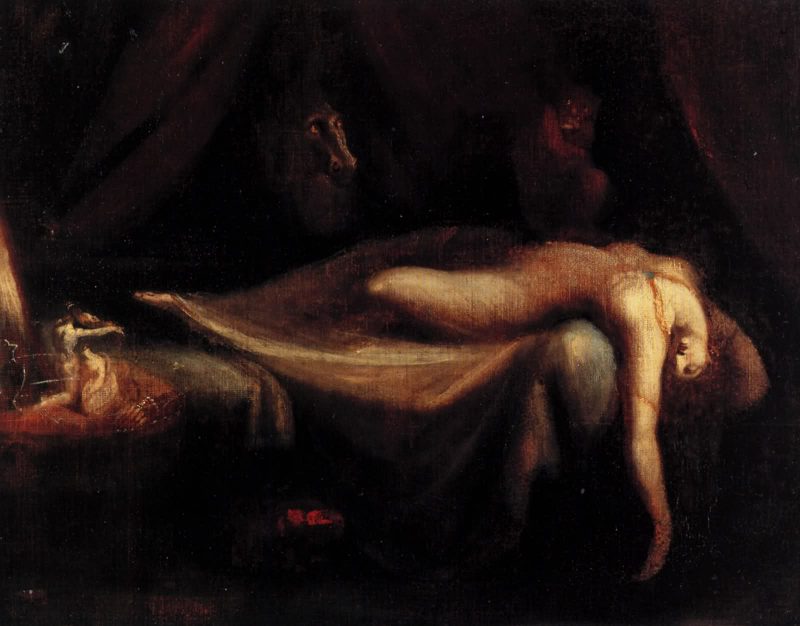
Henri Fuseli third Nightmare-version. Data unknown.
The Mare, Moar or Alp
The nightmare of Fuseli’s rejection by Anna became a very distinctive and powerful work of art, but it does have an exaggerated iconography, making the artistic value of the work (gothic pop-art) more important than the educational content. In addition to the monkey or gnome on the chest, we also see a ghostly horse’s head peeking around the corner. This horse’s head obviously represents the word “mare” in “Nightmare”, but the semantic link to a horse is based entirely on a misunderstanding.
The words nightmare and nightmare have nothing to do with a horse and find their origin in the Northern German Moar (male) Moare (female), Moart, Mahrt or Mare and possibly, but that is speculative, Mare is again linked to the Mares of the Romans. In East Friesland there is also a Woariderske or Wäriderske and in the Wendish-Bucholz district a Murraue. The Murraue also had a male and a female form, just like the male incubus and the female succubus or succuba.
The general term for the creature that causes nightmares, however, is Alp. An attack is called Alpdrücke (the Alp pressing on the chest) and a nightmare is an Alptraum. Although not always obvious, the sexual association with nightmares is as old as the Mesopotamian mythology and the Jewish legend of Lilith.
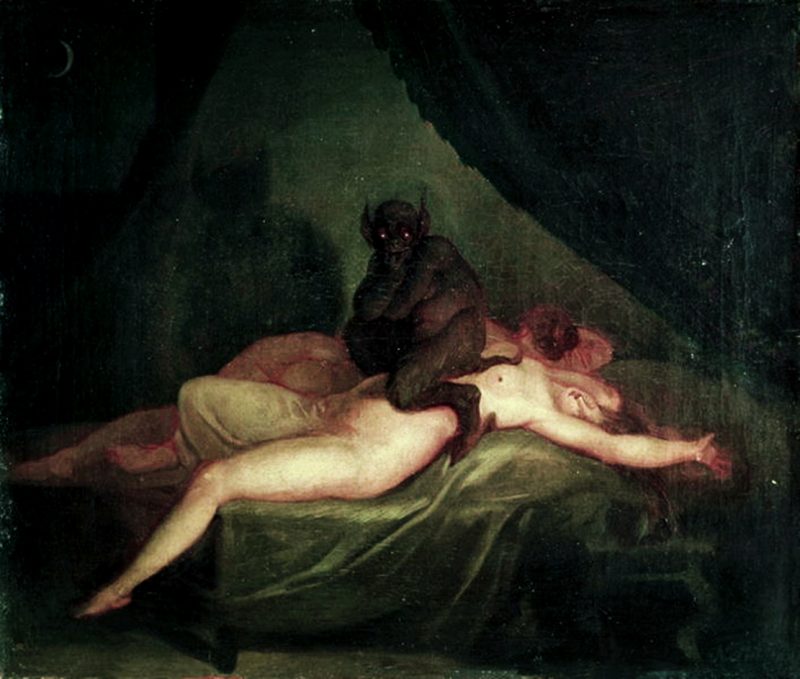
Mareridt (Ride of the Mare) by the Danish painter Nicolai Abraham Abildgaard-1743-1809
Lilith, Samael de incubi and succubi
Originally an important Middle Eastern goddess and often fused with Inanna, Lilith became the archetype of sexual primal force that has a pariah status within the conservative Jewish culture. Legend has it that the incubi and succubi came from the community between Lilith and Samael. They were responsible for erotic fantasies, drives and desires and were particularly fond of lonely travellers and men, who had been away from their wives for a longer period of time. They caused wet dreams and thus the loss of precious life energy and from this wasted seed new incubi or succubi were born.
This belief is not limited to Jewish culture, but we also find it in the Taoists tradition in China. However, unlike Judaism, where masturbation is strictly taboo, the Taoist masters advised men who had to do without a woman for a long time to occasionally masturbate to get rid of their pai-ching (seed without vitality).
Pai-ching blocks the healthy flow of Qi or Ch’i. As for the involuntary nocturnal ejaculations, the Taoist physicians were as concerned as the Jews, because they would be caused by ghosts.

Succubus or Succuba, the female shape of the creature that has the incubus-shape as its male appearance
Incubi and Succubi during the Middle Ages and Renaissance
In the Middle Ages and Renaissance, the incubi and succubi were a major social problem, at least that was made of them by people such as Pope Innocent VIII in his Summis Desiderantes Affectibus from 1484: “Many people of both sexes, not thinking of their own salvation and straying from the Catholic faith, have surrendered themselves to devils, incubi, succubi. Such devils hinder men in performing the sexual act and women in receiving…”
The Catholic opinion leaders’ ban on sex with incubi and succubi regularly led to hysterical excesses and extremely violent political actions. A group that opposed the church taboos were of course the “witches”. A term that should be used with caution here, because there were periods in which every woman in a region was bombarded and persecuted as a witch by the inquisitors without exception.
In his book The Discovery of Witchcraft from 1584, Reginald Scot gives a number of examples of the role that incubi and succubi played in sexual satisfaction. For the sake of clarity, an incubus and a succubus are one and the same being that presented itself to men as a succubus or succuba and to women as an incubus respectively. Thus we read on page 43: “Howbeit M. Mal, proceedeth, affirming that All witches take their beginning from such filthie actions, wherin the divell, in likenes of a prettie wench, lieth prostitute as Succubus to the man, and reteining his nature and seede, conveieth it unto the witch, to whome he delivereth it as Incubus”.
We read how excited women in the field and in the woods pulled up their clothes above their bellybuttons, twisted their bodies lustfully and were then satisfied by a black fog of the length and size of an adult man.
A little further on (pp. 43-44) we read how excited women who had pulled up their dresses above the bellybuttons walked into the woods and fields and twisted their bodies lustfully to get sexually satisfied by a black fog of the length and size of an adult man. Luckily that one voyeur, named James Sprenger, was lurking to capture this kind of outdoor recreation for us: “For proofe hereof James Sprenger and Institor affirme, that manie times witches are seene in the fields, and woods, prostituting themselves uncovered and naked up to the navill, wagging and mooving their members in everie part, according to the disposition of one being about that act of concupiscence, and yet nothing seene of the beholders upon hir; saving that after such a convenient time as is required about such a peece of worke, a blacke vapor of the length and bignesse of a man, hath beene seene as it were to depart from hir, and to ascend from that place”.
A striking detail is that the taste of the incubi is similar to that of the average construction worker. Blondes were particularly popular(page 45):“But here the inquisitors note maie not be fogotten, to wit: that Maides having yellow haire are most molested with this spirit’. Whether or not they whistled at these girls is not known. However, their sense of humour cannot be denied, although one Bishop Sylvanus had very different ideas about this: (page 45): “You shall read in the legend, how in the night time Incubus came to a ladies bed side, and made hot loove unto hir: whereat she being offended, cried out so lowd, that companie came and found him under hir bed in the likenesse of the holie bishop Sylvanus, which holie man was much defamed therebie, untill at the length of this infamie was purged by the confession of a divell made at S.Jeroms toombe”.
Hexenhammer versus incubus and succubus

Malleus Malificarum or Hexenhammer (hammer of the Witches)
We can joke about it now, but for women from the 15th, 16th and 17th centuries it was anything but funny. The aforementioned James Sprenger was actually called Jacob Sprenger, a cunning ambitious Dominican, born in Basel somewhere between 1436-38. Together with Heinrich Kramer, a Dominican from Schlettstadt who had already written an extensive treatise on witchcraft in 1485, he complemented a monstrosity called the Malleus Maleficarum.
The Malleus Maleficarum or Hexenhammer, as the vernacular used to call it, first appeared in 1486, with the approval of Rome, became the handbook for the Catholic hobby-psychopath. The book became extremely popular and experienced reprint after reprint.
In 1520 thirteen editions had already been published, followed by another sixteen reprints between 1574 and 1669. There were at least sixteen German editions, eleven French, two Italian editions and six in the English-language published in the later period from 1584 to 1669.
What the Malleus wanted to achieve in a nutshell, was the fundamentalist implementation of commandment number 18 in Exodus xxii, “Thou shalt not let a witch to live“. Kramer and Sprenger did this by developing an extremely strict code through the Malleus, which subordinated folklore and everything that was understood as paganism to obeying rigid church dogmas.
They even came up with a new etymology for the word “woman”. According to them, Femina (woman) came from fe (faith) and minus (less). Not really of course, because both Kramer and Sprenger were quite gifted and didn’t believe a thing of their own ridiculous theory, but it was a good time for them to use these kinds of tricks to enjoy the most sick expression of misogyny in our history in the name of God. Unfortunately, they were very successful in this, as the thousands of pyres in Europe testify.
The three-volume book, the Malleus, devotes quite a few pages to incubi and succubi, especially in the first part. All of them full of nonsense, historical inaccuracies, faint cult theories and statements to which every Freudian will react with a yawning out of boredom, but all of them neatly arranged administratively and conveniently as befits a solid handbook.
In the book all chapters are equated with a question. Question III for example reads: ‘whether children can be conceived by incubi and succubi’? Question IV reads: ‘By what devils are the practices of incubi and succubi exercised’? Question VI deals with the reason why women copulate with devils, as well as question IV from part 2. Although the questions have been asked very clearly, it does not make you much wiser as a reader if you want to find out something serious about the incubus or succubus. You get lost in references to Augustine, Dionysius and all kinds of biblical quotes, and then the chapter is almost finished. So it’s time to get a bit more serious.
The eternal taboo

Lilith painted in 1892 by John Maler Collier (1850 – 1934)
As a rule, people who are visited by an incubus or succubus at night nurture strong or even fundamentalist taboos on masturbation and feelings of lust. If you look at the old sources, nuns in monasteries are particularly badly affected. In today’s Israel, psychiatrists have their hands full with the psychological problems of young orthodox men, due to the ban on masturbation.
In the case of strongly suppressed sexual drive, the fantasies often present themselves spontaneously and in an increasingly intense form. In men, for example, who have to do without a woman for a longer period of time, an ever-increasing amount of pai-ching accumulates, as we read earlier, according to the Taoist view, and that junk simply has to get out to normalize the qi-stream.
Apart from all Eastern wisdom, every normal healthy man recognizes this phenomenon and it’s just a self-regulating mechanism in the brain that makes sure that when your balls get a little heavy, your fantasy is more and more sent in one direction. You don’t need Lilith, incubus or succubus for that. Quite apart from the fact that the Internet has made these entities pretty redundant.
Yet this more sober, rational view of the matter was already shared by Gervais van Tilbury in 1214. His enlightened vision, however, was overruled by a few centuries of witch-hunting and sex hysteria, until Louis XV’s physician tried again. Saint André believed that the incubus was simply the product of an over-inflated fantasy or naughty behaviour, and that in the latter case the incubus was gratefully used as an excuse by girls and nuns to get into the innocent victim role. But the incubus is certainly not that easy to catch. There is more to it than that. Much more, and with house garden and kitchen psychology we will certainly end up on a dead end.
A brothel full of succubi in Bologna
Cases of copulation with incubi or succubi occur very frequently, through all times and all over the world. There are many common denominators, such as an orgasm that is much more intense than in normal intercourse. The reports of incubi and succibi encounters are also in the Renaissance very accurate and well documented, and show great similarities with reports that can be found on contemporary internet forums on paranormal subjects.
Witch judge Pierre de Lancre (1553-1631) received from the young witch Marguerite de Sare, the confession that she and the witches in Labourd copulated with an incubus in the shape of a billy goat, which had a member the size of a mule, using her whole arm as a measure of length to illustrate this. De Lancre then quotes a report by inquisitor Bogue, who wrote that the witches in Franche-Comté got off with a penis no bigger or thicker than a finger and wrote very ironically that Satan apparently took better care of the witches in Labourd than of those in the Franche-Comté region.

Succubus or succuba seated on a sleeping man
There are many serious reports from men and women who are addicted to succubus or incubus and have long-term relationships with it. Even under the threat of violence or imprisonment, people often do not want to change this. The rumor that sex with a succubus/incubus is much more satisfying than ordinary sex starts with Pico della Mirandola’s story of a man who has a relationship with his succubus for forty years and said that he would rather die in prison than give her up.
In his Les Incubus (1897), Delassus cites an exorcism held in 1643, in which a 20-year-old girl had to be freed from a incubus. The arrival of the incubus was always accompanied by a sudden delirious state of excitement, in which she threw herself on her bed and was unable to concentrate on God. Exorcisms failed because, according to the priest, the girl did not want to lose her incubus at all. Incubi and succubi have an irresistible sex appeal.
In the Compendium Maleficarum from 1608 by Francesco Maria Guazzo, a handsome young man asks the Bishop of Aberdeen to deliver him from a succubus, which has been visiting him for months and is more beautiful than any woman he has ever seen. These kinds of stories have also led to some succubi fables being told.
The original report of Ursuline nuns possessed by sex-demons suggests a notable difference between a sex-demon and the incubus phenomenon, though there lies a grey area in between: “They threw themselves back till their heads touched their feet, and walked in this position with wonderful rapidity, and for a long time. They uttered: cries so horrible and so loud that nothing like it was ever heard before; they made use of expressions so indecent as to shame the most debauched of men, while their acts, both in exposing themselves and inviting lewd behaviour from those present, would have astonished the inmates of the lowest brothel in the country.” (Quote from: The History of the Devils of Loudun – revised edition by VAMZzz Publishing). Incubi and succubi hardly possess a person in the classic way the Catholic Church describes possessions. There are relations between men or women and their succubus or incubus, sometimes very pleasant ones, but in most cases incubi/succubi-encounters are one night stands.
The most remarkable historical anecdote however reports of a brothel in Bologna, where a number of succubi were exploited. Even more remarkable, however, is that the operator was actually sentenced to death for this offence in 1468. You could easily protect yourself against incubi and succubi by carrying a red peony, a peony root, a piece of red coral or a red jasper or pebble with you. The rest of this article raises the tantalizing question of whether this is advisable or not.
The incubus – succubus, the faun, satyr and nymph
Apart from the overlap they share with a darker and more violent kind of sex-demons, there is also a link between the faun or satyr or nymph and the incubus-succubus. This link was already made by Sinistrari of Ameno in his book Demoniality. Francis Barret (1770-1780) describes the succubi as forest-nymphs in his book The Magus in 1801 and refers to the delusions of Satan as unnecessary:”And seeing the fauni and nymphs of the words were preferred before the other [spirits] in beauty, they afterwards generated their offspring among themselves, and at length began wedlocks with men, feigning that, by these copulations, they should obtain an immortal soul for them and their offspring but this happened through the persuasions and delusions of Satan to admit these monsters to carnal copulation, which the ignorant were easily persuaded to and therefore these nymphs are called succubi although Satan afterwards committed worse, frequently transchanging himself, by assuming the persons of both incubi and succubi in both sexes for they conceived not a true young by the males, except the nymphs alone.”
The incubus and succubus in modern days

Fritz Schwimbeck (1889-1972) – Mein Traum, mein böser Traum uit 1915
Modern reports of incubi and succubi have been growing rapidly since OBE (Out of Body Experience) began to become a popular phenomenon. Ever since the publication of Robert A. Monroe’s Journeys of the Body in 1971, the interest in consciously projecting the energy body or making astral journeys has increased dramatically.
The biggest boost came with the work of writer Robert Bruce, Astral Dynamics, followed by New Energy Ways and recently the book Mastering Astral Projection, 90-day guide to out of body experience. Bruce has an extensive forum via www.astralpulse.com, in which people participate with mostly serious discussions, questions and frank exchange of experiences. In relation to the incubus or succubus, you come across these kinds of entries:
“I have been visited twice by an incubus/succubus in the past. Both times after intensive trance/energy work, perhaps the most intensive thing I have ever done. The first time I was scared and didn’t know what was going on. I cut off the experience and that’s exactly why I was very curious the second time and let it happen in its course. The creature manifested itself as a handsome girl. I was partly in a trance and didn’t fight against anything’…//… ‘I’ve had quite a bit of good sex in my life, but nothing even came close to what I had the night before”.
Although horror films transform the image of an irresistible sex partner into a gruesome demon according to the “Lamia formula”, you will never find anything of this within the serious research into the incubus phenomenon. Neither the ancient nor the recent stories explicitly show that an incubus or succubus is a destructive evil being or even a demonic entity. The incubus/succubus seems to be a separate class of what Robert Bruce calls astral wildlife.
(retranslated from my earlier Dutch translation) I have some first-hand observations of incubus entities and my description of them was independently confirmed by others. Incubi are actually very beautiful to see and not terrifying at all. They look like a cellular organism, a bit like an amoeba. Seen clearly or with astral vision, while they are in the real time-zone and manifest themselves close to the physical dimension, their real form is an oval of about 18 inches to 3 feet (± 40-90 cm) and they seem to consist of a kind of clear jelly. Inside the body, hundreds of small speckles of light shine in all kinds of colours. At one end there is an internal structure that looks a bit like a red daisy. This seems to be the back end. The incubus pulsates with a dense red glow when it moves. It moves fast and with fits and starts, just like many other creatures from the astral fauna move when they are observed with astral vision.
Incube-type entities usually attack quickly and with great force. Their victims usually sleep, but not always. Sometimes they attack someone in their sleep, sometimes when someone is awake, but relaxed. During the first type of attack, the incubus attaches itself directly to the genital energy centre and very quickly causes a forced orgasm. The second type of attack works with the telepathic and hypnotic transmission of sexual dreams or illusions, along with the stimulation of the genital centre. When someone wakes up during the attack, the incubus will often create the illusion of a beautiful human body that sits on top of the victim and performs all kinds of sexual acts. The end result is always the same; an orgasm that is many times more intense and intense than the victim can normally get. This is due to the direct stimulation of the second chakra.

Incubus-Succubus drawing by Benjamin Adamah after a description of its astral shape by OBE-expert Robert Bruce
Dwellers on the Threshold
But what about the monkey on the chest? Well, according to King James I and his famous Demonology from 1597, that’s all right. Rowing against the current of the demonological mainstream of his days, he writes that the incubus is simply a disease, a kind of ‘thick phlegm that falls on our hearts in our breasts and that robs us of all our powers’. As a result, we think that there is an unnatural burden on our breast, a spirit lying on us that squeezes us down. For those who have ever had the classic nightmare experience, and fortunately I can count myself among them, this is of course not the most satisfying explanation. I myself think that also, to explain the monkey or gnome, we have to find the more plausible answer in, again, the OBE-phenomena linked to an unorthodox vision on the process of falling asleep and waking up.

Le Cauchemar (the Nightmare) 1894 by Eugène Thivier
One of the highest thresholds that people who consciously resign have to deal with is the phenomenon of the so-called sleeping paralysis, the feeling of being temporarily paralysed at the moment of resignation. This can be very frightening. This phenomenon is also very common in people who do not consciously withdraw from their physical body and this is because our energy body, or ethereal double, partly “leaves” our physical body to recharge energetically. This is the main function of sleep from the esoteric-energetic perspective. Anyone who has ever consciously moved out of his or her body may have had the experience, that at the moment of release from the physical body, a sudden state of intense sexual excitement may occur. This too is a barrier that can make perseverance in OBE experiments difficult. The fear during the paralysis and the overwhelming feelings of lust are sometimes regarded as so-called Dwellers on the Threshold. Forces that prevent us from entering another dimension. The English esoteric Sir Edward Bullwer Lytton, in the Rosicrucian novel Zanoni (1842), combined fear and lust in his Dweller on the Threshold:
… “the Phantom glided slowly into the chamber. The cloud retreated from it as it advanced; the bright lamps wan, and flickering restlessly as at the breath of its presence. Its form veiled as the face, but the outline was that of a female…//… “Thou hast entered the immeasurable region. I am the Dweller of the Threshold…//…Kiss me, my mortal lover.” and the Horror crawled near and nearer to him, its breath breathed upon his cheek!”
If you manage to pass the first “guards” and an astral exit takes place, then many astral travellers report independently, other scaremongers such as a kind of roar – you can also hear when raising kundalini – or seeing gargoyles, monkey-like devils with a nasty grin on their face, as the most common. Thus we find in the hypnagogic state between sleeping and waking and between two dimensions, all the ingredients (fear, lust, paralysis and a monkey-like being) for the classic nightmare experience combined.
Incuba
Sie kommt zu mir in wechselnder Gestalten,
wenn mich der Schlaf dem Erdenleid entrückt
und bunte Bilder spielend sich entfalten:
Sie kommt zu mir im Traum, der mich beglückt.
Mit ihrer Glieder unerlöster Fülle
Bedrängt sie mich, das es mich heiß ergreift,
wenn sie der Kleider mir verhaßte Hülle
sich von den Schultern, von den Hüften streift.
Sie ist erfinderisch in alle Lüsten,
in allen Künsten, die die Liebe beut;
in ihren Armen und an Ihren Brüsten
gnieß’ ich Wonnen, die ich bereut.
Wer bist Du, Weib? Aus welchen Regionen
Erscheinst Du mir? Wer hat sie Dich gelehrt?
die Seligkeiten, die im Kusse wohnen,
die Reize, die ein Griff, ein Druck gewährt?
Sie aber schweigt voll Heimlichkeit und List
Und lächelt nur mit halbverschloss’nem Munde,
der wollusttrunken, feucht und lockend ist
und blutigrot wie eine frische Wunde.
Und nimmermüd, mit Küssen ohne Zahl
Und mit Umarmungen die mich betäuben,
erneuert sie die wundersüße Qual;
Da hilft kein Wehren und da hilft kein Sträuben.
In ihren Augen flackert wilde Glut;
Sie schlägt ins Fleisch mir lange, spitze Krallen,
wirft sich auf mich und saugt mein warmes Blut
O Lust! O Pein! – Die süßeste von allen!
Und wie ich jubelnd sie umschlingen will,
da ist sie fort. – Ich höre noch ihr Lachen,
dann wird es dunkel um mich her und still,
und auf die Lust folgt kläglich das Erwachen
– Dr Franz Sättler Musallam 1884 -1942
You may also like to read:
Witches ointment
The real vampire in Russia and Slavonic countries
Historical werewolf cases in Europe
Poltergeist
Why did Witches Want to Ride their Broomsticks?
Hecate – The Calling of the Crossroad Goddess
The Ancient Witch-Cult of The Basques
Walpurgis Night
Stefan Eggeler: Walpurgis Night witches, Kokain (Cocaine) and other illustrations
Witchcraft paintings – Dutch 17th century
Rosaleen Norton, Daughter of Pan
Mysteries of the Ancient Oaks
Black Cat Superstitions
The Mystical Mandrake
Little Secrets of the Poppy
Datura stramonium or jimson weed or zombi-cucumber
Mountain spirits
Wild Man or Woodwose
Sprite
Claude Gillot’s witches’ sabbat drawings

